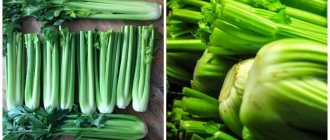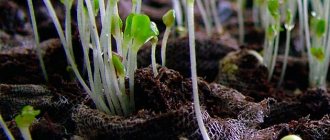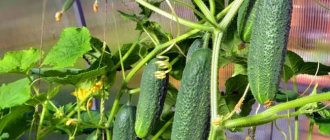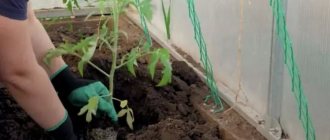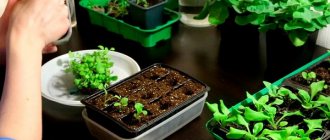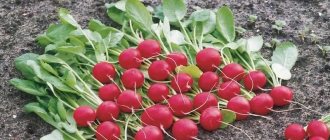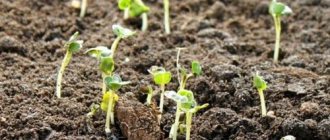5/5 — (5 votes)
Hello, friends. Today we continue the topic of celery. If earlier I talked about the root variety of this vegetable, today we will study its leafy counterpart, and at the same time we will talk about its similarities and differences with stalk celery.
The main difference from root celery, of course, is the purpose of the vegetable - it is grown for the sake of producing green leaves. The root system is not very developed, and its root is not eaten. The most valuable thing about the leafy variety is the lush, aromatic greens that can be eaten throughout the summer season. Instead of cut leaves, new ones immediately grow, and they are more juicy and tender than, for example, parsley.
By the way, in the photo below there are three varieties of vegetables.
Celery is not a fussy plant and is quite easy to grow. But in order to grow it, as with any other plant, you need to know its preferences and characteristics. And today’s article is just about this.
Types and varieties of celery
Three types of celery are cultivated in gardening. They are classified according to which parts of plants they eat:
- root;
- sheet;
- petiole.
Celery root is comparable to ginseng in its effects on the body. When ripe, its root vegetables weigh 500-900 grams.
The most common varieties:
- Anita;
- Prague Giant;
- Maksim;
- Gribovsky;
- Albin;
- Strongman.
The leaves and roots of petiole celery are of no value.
The following varieties are popular among gardeners:
- Malachite;
- Tango;
- Gold;
- Triumph.
The advantage of the leafy type is the ability to eat fresh greens throughout the season. A healthy and tasty crop can bear fruit in a personal plot all summer long.
The following varieties are distinguished:
- Gentle;
- Spartan;
- Cheerfulness;
- Samurai;
- Sail;
- Zakhar.
By planting seeds in open ground, you can grow petiole and leaf varieties. And only their early varieties. For mid-season and late-season crops of these species, as well as root celery, this method is not acceptable. Their cultivation is carried out exclusively with preliminary planting of seedlings.
Diseases and pests
Leaf celery is not susceptible to disease if grown in good conditions. However, any violation of the rules of care may result in symptoms of one of these diseases:
- Rust. Orange spots appear on the bottom of the leaves and petioles. The plant begins to dry out;
- Downy mildew. A white coating forms on the greenery, gradually becoming felt-like;
- Septoria blight is characterized by spots on stems and leaves that are round in shape and dark brown in color.
- Cercosporosis appears as light gray spots; in later stages they acquire a purple tint.
Only specialized powerful drugs help against diseases. You should not look for information on how to feed leaf celery using folk methods. They are all ineffective and can lead to crop loss.
Pest control is not an impossible task. Fungicides should not be used on celery as they will accumulate in the greens. Affected plants should be destroyed and the soil treated with a weak solution of manganese for disinfection.
When to plant celery seedlings
Note! Root celery is sown earlier: in the last days of February.
Leaf and petiole species - in the first half of March.
This is average data. The main criterion for determining planting time is the manufacturer’s recommendations indicated on the seed packaging. It is also worth considering the climate of the area where the plot is located. Often, when determining the sowing date, the phases of the moon are taken into account. The combination of all these factors will allow you to determine the exact date when to plant celery seedlings.
According to the lunar calendar
Most gardeners tend to adjust planting times by checking the lunar calendar. It is believed that the moon has a great influence on plant growth. Her cycle does not coincide with the calendar month. Therefore, every year has its own favorable and unfavorable dates.
The Lunar Sowing Calendar for... will help you choose favorable planting dates.
According to manufacturers' recommendations, depending on the variety
Seed producers provide their recommendations regarding planting. Not only the variety is taken into account, but also the characteristics of this particular seed.
Typically there are three date ranges:
- optimal sowing time;
- recommended dates for planting seedlings;
- planned ripening period.
Depending on region and climate
In regions with milder climates, sowing begins earlier. Since in April the plants can be planted in the garden.
In the northern regions, cold weather will not allow this to be done before May-June. Accordingly, the sowing dates will shift to a later time.
Selection and preparation of planting material
When planning sowing of a valuable vegetable, the following factors must be taken into account:
- the timing of ripening or the onset of economic ripeness, based on the biological characteristics of the selected variety;
- the duration of the frost-free period in a specific climatic zone;
- approximate date of end of spring frosts;
- the optimal age of seedlings at the time of their planting in open ground;
- seed quality.
Varieties and hybrids
Depending on the timing of ripening, varieties of petiole celery intended for garden growing conditions are divided into early, mid-early and mid-ripening. Their growing season ranges from 83-135 days to 160-180. When choosing a suitable variety or hybrid, it is important to take into account the climatic conditions of the region; for example, mid-season varieties are successfully grown in the Central Black Earth Region, while in the Urals and Siberia it is better to give preference to early varieties.
The plant is cold-resistant, but at temperatures below +10 ℃ it tends to bloom in the first year of vegetation
As of 2022, more than two dozen varieties and hybrids recommended for cultivation throughout the country are officially registered in the State Register of the Russian Federation. The main characteristics of some of them, including the time frame for achieving economic suitability after the appearance of full shoots, are considered in the table:
| Name of variety/hybrid | Socket height, cm | Weight of one plant, g | Maturation period, days |
| "Atlant" | 40-45 | 300-340 | 165-170 |
| "Cheerful day" | 90 | 250 | 135 |
| "Vyacheslav" | 45 | 150 | 120 |
| "Groom" | 45-48 | 320-390 | 150-160 |
| "Royal" | 60-70 | 150-180 | 85-95 |
| "Mambo F1" | 30 | 220-250 | 83 |
| "Monterey F1" | 50 | 480-500 | 80-100 |
| "Tango F1" | 50 | Up to 1000 | 160-180 |
| "Crunch" | 40-45 | 350-400 | 140-160 |
Manufacturers usually indicate information about the duration of the growing season on seed packages.
Determination of sowing dates
The optimal time for preparing petiole celery seedlings is selected as follows: from the start date of the frost-free period (after the end of return frosts), the recommended age of seedlings in days is counted in reverse order according to the calendar. For example, if in the middle zone the risk of frost remains until the end of May - beginning of June, and seedlings of most varieties are grown at home for up to 70-90 days, then the seeds should be sown in the second half of February - the first ten days of March.
Seedlings are considered ready for planting in open ground if they have 5-6 leaves and a well-developed root system
Germination inhibitors
Celery seeds, like other umbelliferous seeds, have a feature that affects germination and, consequently, the duration of the seedling period. It consists in the presence of a large amount of essential oils, which inhibit the process of swelling and emergence of seedlings for up to two weeks. Before sowing, care must be taken to remove natural inhibitors from the seeds. To do this, planting material is soaked in clean water at room temperature for 2-3 days. It is recommended to change the water every 5-6 hours. If measures are not taken to remove essential oils, then it is necessary to take into account the delay in seed germination and shift the sowing date to an earlier date.
Considering the slow germination of seeds and the long growing season, pre-sowing preparation begins, as a rule, in February
How to plant correctly
Obtaining strong seedlings primarily depends on adherence to technology. The final result is influenced by the preparation of the seeds, the composition of the soil and the choice of container for planting.
In what soil
Substrates for planting vegetables are sold in gardening stores. The composition of such mixtures takes into account the characteristics of the plants for which it is intended. You can prepare the soil for seedlings yourself.
To do this you will need:
- lowland peat – 3 parts;
- turf land – 1 part;
- humus – 1 part;
- sand: river or quarry.
Additionally, urea and ash are added as mineral fertilizers. The first is for feeding plants with nitrogen, the second is for minerals. It is advisable to mix the components a few days before planting. After preparation, the substrate is disinfected by pouring a solution of a fungicide against fungal diseases and potassium permanganate.
Recommendation! If containers without holes in the bottom are used for seedlings, drainage is first placed at the bottom. Gravel, pebbles or expanded clay are suitable for this. Only after this the container is filled with soil.
Capacities
Containers of various sizes and configurations are used as containers for germination in gardening.
Examples of the most commonly used containers include:
- peat pots;
- plastic containers;
- disposable tableware;
- food cups;
- plastic cassettes for seedlings.
The determining factors of choice are practicality and accessibility. For plants, the nutritional and structural qualities of the soil are important. As a rule, they take small containers. Consider the convenience of watering and placement on the windowsill.
Preparing seeds before sowing
Before planting, seed material is prepared. The measures taken are aimed at increasing the percentage of germination and germination rate, and preventing plant diseases. There are several mandatory rules for pre-sowing treatment.
Recommendation! At all stages of growing celery from seeds, use prepared water: settled, boiled, melt or rain.
- Disinfection. Disinfection of planting material to destroy pathogenic microorganisms that can harm crops. Use ordinary potassium permanganate, add one gram of potassium permanganate per glass of water and process for half an hour.
- Stratification. The seeds must "overwinter" before they are ready to germinate. The procedure can be carried out both before the disinfection stage and after its completion. Seeds are evenly sprinkled onto a damp cloth. This is convenient to do on a wide plate. Cover the top with another layer of cloth, put it in a bag and put it in the bottom of the refrigerator for two weeks, the cloth needs to be moistened all this time.
- Soak. The seeds are poured into a bowl or container. Then pour in a small amount of warm water. The liquid layer should not be more than 3–5 mm. The soaking stage lasts on average two days. During this time, the water is changed several times (every 4 hours). To determine the exact period, they are guided by the appearance of the seeds. When they swell, they move on to the next stage.
- Germination. For sprouts to appear, the seeds are kept between layers of damp cloth. The procedure is carried out in a warm place for three to four days. As soon as small sprouts appear, begin planting. Germination allows you to determine the germination of seeds and carry out screening before sowing in the ground.
Healthy! Carefully read the information from the manufacturer on the seed packet. In some cases, seed material undergoes stratification and/or disinfection before sale. In this case, the stages are excluded from the pre-sowing treatment algorithm.
Sowing seeds in the ground
- Prepare a container for sowing and fill it with prepared or purchased soil.
- Keep the soil well moistened by watering it deeply and allowing the moisture to soak up.
- Carefully, so as not to damage the sprouts, distribute the seeds over the surface, in rows at a distance of 3–4 cm. If small individual cups are used, then place 3 seeds in them. Sprinkle a few millimeters of peat or sifted wet sand on top.
- Cover containers with plantings with film or glass.
- Place the plantings in a warm, bright place.
Important! When planting, do not press the seeds. Because tender sprouts can be easily damaged.
As a rule, shoots appear after 14 days. The containers are ventilated daily. The soil is moistened as necessary. After emergence of seedlings, the polyethylene is removed.
Picking
When the seedlings grow up, pick them. This happens two to three weeks after planting. For petiole and leaf celery, thinning is practiced. Simply remove less developed and weak plants so that empty space is formed between the remaining plants. The recommended distance is 4–5 cm.
Root celery is planted in individual peat cups. Plants weakened by transplantation are kept in the shade for the first few days. Until planting in the ground, it is recommended to maintain a temperature of about fifteen degrees.
Is it possible to grow celery at home?
If we are talking about obtaining root vegetables at home, then this is only theoretically possible. Of course, you can create artificial conditions, but does it make sense to maintain high illumination for six months and create long daylight hours in order to obtain several fruits? But it is quite possible to get vitamin-rich greens in winter by planting a commercial celery root crop in a pot, which is often done. But it would be more correct to call this process not growing, but forcing greens.
Growing conditions
You can get celery leaves at home on an insulated balcony, if the temperature there is not lower than 10 ° C, or on a lit windowsill. The root crop for this can either be bought in a store or taken from your own summer harvest. It is important that it is not too small: at least 5 cm in diameter. No special conditions are required: you need a large pot, a place for it and a little effort in watering and maintaining sufficient lighting.
Landing
You can plant root vegetables both in early spring (on the balcony, to obtain spring greenery), and immediately after digging up root vegetables in the garden (on the windowsill, for winter harvesting of vitamin products). However, it is worth understanding that the duration of the arrival of tender leaves will not be long: after two months, the leaves will be aromatic, but very rough; they can be used in cooking, but not in salads. This means that a new root crop will need to be planted.
Any flower pot or small bucket is suitable as a container. Several specimens can be planted in a large container, but not close together. It is advisable to place a small layer of drainage at the bottom, but there are no special requirements for the soil for forcing leaves: soil of any normal composition will do. True, you can bring weed seeds from the garden with it, but this is not scary: weeding is not a difficult task, it is worse if it contains unpleasant insects. The root crop must be planted so that its top is not covered with soil.
Care
Caring for plantings is elementary. Celery in a pot should be watered frequently, preferably with settled water. Watering is required abundantly, but without fanaticism: the soil should not become sour, otherwise the root crop will simply rot. It is better to keep the pot on a southern windowsill: you need a lot of light. If we are talking about winter time, you will have to equip additional lighting: a short day will not make it possible to obtain a bountiful harvest, even of green products.
At home, we can only talk about obtaining green products
The first leaves can be cut off in 2-3 weeks. To prolong the harvest, the soil in the pot must be loosened periodically. Is it worth feeding? It seems that it is better not to do this: as long as the root crop has enough of its own strength, let it expel the foliage. For your own health, it is better to get natural products, and after a couple of months replace the soil and root crops in the pot.
Seedling care
By the time of planting in the beds, the seedlings should be strong and healthy. To do this, she requires competent care. It consists in organizing the optimal temperature regime of lighting. As well as timely watering and fertilizing to provide crops with nutrients.
Lighting
Daylight hours during the growing period of seedlings are short. The weather, as a rule, is not often pleasant with sunny days. As a result, due to lack of lighting, the seedlings become very elongated. Plants grow weak and thin. Celery requires additional lighting for normal development. To organize it, fluorescent lamps are used.
In the first week, artificial lighting is provided around the clock. Subsequently, the lamps are turned on in the morning and evening, artificially increasing daylight hours. And also in cloudy weather to compensate for the lack of sunlight.
Temperature
The optimal temperature for seed germination is about 26 ºC. After germination, the temperature is lowered by ten degrees. Under colder conditions, the development of plantings slows down greatly.
If the seedlings are hot, they will begin to suffer from dehydration. A still weak root system will not have time to compensate for moisture loss, and the plants will wither.
Watering and humidity
A humid microclimate is required for seed germination. It is supported by covering containers with plantings with plastic film. When the soil dries, it is moistened with a spray bottle. After germination, high air humidity is not needed and the film is removed. Throughout the entire period of growing seedlings, make sure that the soil is moist, but without standing water.
Advice! Until the seedlings become stronger and firmly established in the soil, water with extreme caution: with a pipette or syringe.
Use only prepared water at room temperature. After watering, carefully loosen the top layer of soil so that a crust does not form.
Top dressing
Before picking and 14 days after, celery is not fed. It only needs the nutrients that are already in the substrate.
In most cases, two feedings are carried out.
The first - two weeks after picking (0.5 teaspoon diluted with 1 liter of water). This fertilizer will help pale green or yellowish seedlings gain strength.
The second - after the appearance of 3 true leaves, no earlier than 10 days after the first. You can use complex fertilizers, for example, “Solution”, liquid concentrates of humic substances “Ideal”, “Gumi”.
A solution (1 tablespoon of sodium or potassium nitrate per 5 liters of water) is well suited for feeding root celery.
Good to know. If the leaves are pale with a yellowish tint, then the plants do not have enough nitrogen compounds in their diet. This can be corrected by adding urea or saltpeter.
Common Mistakes
The bulk of errors occur during the period of growing seedlings. The most common mistakes when growing celery:
- Violation of the thermal regime. The plant will not sprout on time if a comfortable temperature of 18-20°C is not provided.
- Incorrect watering. You cannot pour water on top of the seedlings - they will sink to the ground and will not rise again. Water is poured under the root or through a sieve.
- Dry soil. If the soil is allowed to dry out, the plant will not develop.
- Large depth of seedlings during picking or planting in the ground. If you cover the central bud with soil, it will not sprout - the plant will slow down or stop growing altogether.
- Lack of light. Because of it, plants stretch out and turn pale. Seeds are sown in March, when daylight hours are still short. The problem is solved by organizing artificial lighting.
- Neglect of hardening. Even the strongest seedlings need hardening before planting in the ground. It is taken out into the open air before being transplanted into the ground.
When to plant seedlings in open ground
The site for planting is prepared in the fall. Choose a place that is as illuminated as possible, not shaded by bushes and buildings.
The soil is dug up and rotted manure (7 kg per 1 sq. m) and superphosphate (10 g per 1 sq. m) are added. They can be replaced with wood ash.
In the spring, before planting, organic fertilizers are added to the soil. If the soil is depleted, additional humus is added to it.
In early May, if the celery is 11–12 cm high and has at least 5 true leaves, plant it. Naturally, the earth must warm up and thaw.
If the seedlings are planted, but there is a risk of frost at night, arcs are placed over the bed and covered with polyethylene. The film is removed for the day. The distance between seedlings when planting depends on the type of celery. For leaf and petiole - 15–20 cm, and between rows - 30 cm for root - 40 cm - the distance between seedlings and 50 cm between rows.
Remember! Do not overly bury the celery root. Because this will cause active growth of adventitious roots and deformation of the root crop.
Reviews
★★★★★
Elena Kononenko, 45 years old, Murom. Many people don’t like celery, but I really appreciate it as a seasoning; it enhances the taste and adds interesting flavor notes to the dish.
I plant it only as seedlings - to quickly get greenery. The most difficult thing is to get good seedlings; sometimes they stretch out excessively, sometimes they wither for unknown reasons. ★★★★★
Maria Shorokhova, 37 years old, Tver region. I grow celery right in my apartment.
It helps me maintain youth - I use it as a vitamin supplement and a cosmetic product. In order to always have fresh celery leaves on hand, I grow it in pots - I plant fresh roots bought at the market there. Hide
Add your review
By planting leaf celery in open or closed ground, you can add the leaves of this healthy plant to ready-made dishes at any time. Using different growing technologies, you will be provided with celery greens all year round.
0
1
Copy link
Caring for celery seedlings after planting in a garden bed
To get a good harvest, fertilize celery with organic matter once a week. Good results are obtained when using weed tincture as a fertilizer (1 liter of weed infusion per 5 liters of water) with the addition of superphosphate (1 teaspoon per 10 liters of solution). You can use other organic fertilizers with the exception of fresh manure.
With the beginning of the formation of the root crop, to prevent the formation of voids in it, boron is added to the soil as a top dressing (2 g per 10 liters of water).
Naturally, regular watering is required. The soil should be constantly moist, but without standing water. As the plant grows, make sure that there are no more than 5 leaves. If necessary, remove the outer leaves. From root celery, the lateral roots are periodically cut off and hilled up. Otherwise, the root crop will branch.
Proper care will ensure an autumn harvest of large, dense, beautiful and tasty root vegetables without a “beard”.
Useful properties, characteristics and description
Celery belongs to the umbelliferous or celeriaceae family of plants. Today, almost 20 species of this greenery can be found in nature. Celery is one of the most common crops. In addition, it belongs to vegetable crops.
To obtain greens and roots for use, this biennial plant is grown for one year. The second year is spent on the plant flowering, and then on the formation of the fruit, in which the seeds ripen. Celery leaves have a simple structure with a pinnately dissected pattern. The plant blooms with small flowers, which are collected in the form of an umbrella.
As for any type of celery root, it is a taproot. Even a plant called “root” also has a stem. It just has this peculiarity: it is thickened at the root and forms a root vegetable. This can be clearly seen if you pull the plant and its roots out of the ground.
The wonderful properties of celery are known to everyone. It is useful even for the smallest children, especially in the spring to prevent hypovitaminosis.
The vegetable is rich in vitamins from the group B1, B2, B6, C, E, K, PP. Also, it contains a large number of microelements: iron, phosphorus, magnesium, sodium calcium, etc.
In addition, celery contains essential oils and amino acids such as lysine, histidine and arginine. Not long ago, coumarin was discovered among the components of the plant, which is used for preventive purposes against malignant tumors.
Today, celery is often used to combat excess weight. It has a small amount of calories, but the body has to spend a lot of energy to digest it.
This vegetable crop is capable of quickly destroying layers of fat and also frees the body of toxic substances.
Celery is beneficial for men's health as it is a strong aphrodisiac.
When to harvest and how to store the crop
The harvest season for petiole and leaf celery begins at the end of September. Kornevoy - from mid-October. Finish harvesting before the first frost. To determine the maturity of root crops, they are pulled out of the ground and knocked on. Celery is ripe and suitable for storage if it makes a ringing sound when struck. Three weeks before harvesting, petiole celery is hilled. This measure will reduce the bitter taste and characteristic odor.
Harvesting petiole and root species involves digging them out of the ground. With leaf species, they do things differently. Either the leaves are cut off or, to increase shelf life, they are transplanted into flowerpots. A pot of celery on the windowsill will please the eye and, most importantly, provide delicious dishes with vitamins.
On a note! Root vegetables are stored in boxes with damp sand or in plastic bags. Recommended storage temperature is about 2 °C. Shelf life is from three months to six months.
Growing in a greenhouse
Celery is a biennial plant, so its life does not end with the onset of winter. It is grown in winter in a heated greenhouse in two ways:
- Growing up. The life of a plant is extended by replanting it from open ground to a greenhouse. They receive fresh greens until December - 45-60 days.
- Forcing. Plants grown in the ground are harvested and stored until April - in the dark, at a temperature of 3°C. They are planted in a greenhouse in winter, ensuring a temperature of 12-18°C and a humidity of 60-80%. The harvest can be harvested after 20 days.
Benefits for men
Celery has a beneficial effect on men's health. Chereshkovy stimulates the production of the male hormone androsterone, which enhances potency and libido. Regular consumption of the root and leaves normalizes blood pressure and rejuvenates the body, reduces irritability, calms, and improves memory.
Women
Celery is recommended for women to consume to maintain the natural beauty of skin, hair and nails, reduce fat deposits, normalize metabolism and water-salt balance.
The plant has a negative calorie content - the body spends more energy on its processing than it receives. Due to this feature, the leaves, petioles and roots are included in low-calorie diets. Celery juice reduces the vascular network on the legs, reduces the likelihood of developing varicose veins.
Children
Celery is good for a growing body. Greens, roots and stems are allowed to be introduced into the baby’s diet starting from 7 months. By this time, the digestive system will be ready to digest fiber.
Moderate consumption of the product in childhood:
- promotes rapid regeneration of damaged skin;
- improves digestive function;
- increases iron levels;
- relieves pain;
- removes uric acid salts;
- stimulates appetite;
- has a mild sedative effect.
Harvesting
Celery is left in the beds for as long as possible, since this crop continues to gain weight until October. One of the main signs of root maturity is the yellowing of the lower leaf of the plant.
They dig it up only before the onset of frost. To collect root vegetables, use only pitchforks, not shovels, as the fruiting body can be damaged.
When harvesting root celery, they are not in a hurry, unlike other root vegetables, to remove the leaves. The tops are cut off after 3-4 days so that the nutrients from the leaves have time to move into the underground part of the root crop. Cut off the tops with a small part of the fruiting body. The cut should be smooth and continuous, not torn.
Carefully trim the small roots on the root crop.
A bundle for memory. Small roots are washed well, chopped, dried and added to the company of other white roots - parsnips, root parsley.
Rules and landing scheme
Celery in the garden takes a long time to form, regardless of what type it is. On average, root - 200 days, petiole - 120 days, leaf - 100 days. Therefore, it is more profitable to grow through seedlings.
Rules for planting celery
Time for planting seedlings:
- root: early February;
- petiole: at the end of February;
- leafy: in March.
It is better to sow in boxes.
- The soil should be nutritious and light. It is spilled, then the seeds are scattered in the box, but not covered with soil. Just cover with film or light covering material to increase the humidity. Plastic containers with a lid will do.
- Planted at a distance of 2-2.5 cm.
- It is better to moisten the soil with a spray bottle so that the seeds do not wash away.
- Germination occurs at a temperature of +25 ° C, so the container is placed in a warm place.
- The film is removed once a day for a few minutes to prevent mold from forming.
When the first leaves appear, the film can be removed, but the container is kept warm for another week. Then they are transferred to a cool place, into the light. At average air temperatures it will grow stocky and tasty.
The crop is planted when 4 leaves appear. Plastic cups will do.
- The seedlings are watered abundantly.
- Drainage holes are made in the cup to drain water.
Root varieties are planted in the garden in mid-April. Others - in mid-May. If the spring is warm, then leafy species should be planted in the second half of April. If the plants are too deep, they will grow difficult.
You need to understand at what distance to plant:
- root - between rows 50 cm;
- petiole - 20 cm;
- sheet - 15 cm.
You should not cover it in the garden because it easily tolerates cold, especially if you harden off the plants first.
Timing of sowing and replanting in the ground
Leaf celery is characterized by relatively slow growth, and it is almost impossible to obtain vigorous shoots, so the crop is grown mainly by seedlings.
At home, sowing is done in early March, and in the first ten days of May the plants are transferred to a permanent place.
This is interesting:
The best varieties of dill for greens without umbrellas for growing in greenhouses.
When is it time to collect carrot seeds and how to do it correctly.
general description
The most popular is the cultivation of petiole celery, which is relatively resistant to cold, allowing you to get a good harvest even in the short summer of the middle zone. Such greens not only have a great taste, celery contains numerous microelements and vitamins, and the wound-healing, antiseptic and diuretic properties of this plant have been established.
Celery is native to Asian countries; this plant is common in India and southern China. In the past, growing celery was difficult, since at the slightest drop in temperature, the growth of this crop stopped, which did not allow summer residents and gardeners to get a good harvest. However, today cold-resistant varieties have been bred, zoned to the middle zone and Siberia, which are easy to care for and have excellent productivity.
What fertilizers are good for celery root?
Celery is responsive to fertilizing and fertilizing. Give preference to organic substances. Fermented weed is an excellent feed for all types of celery. It is important to dilute the fertilizer correctly so as not to burn the root system. Typically a ratio of 1:10 is used.
Watering the crop can be combined with fertilizing. If celery is planted in poor soil, phosphorus-potassium supplementation is required. Dissolve potassium sulfate or potassium magnesia in water in the following proportion: 20 g of fertilizer per 10 liter bucket.
What is celery
The ancient world grew the crop to decorate graves and prepare food for funeral dinners, and European countries to create landscape designs. But over time, celery began to be planted for consumption in everyday life. Many chefs note that dishes prepared using the plant acquire a rich taste and aroma.
A perennial vegetable crop, it has several types with a thickened root, the leaves look like feathers with a cut in the middle. The plant grows up to one meter. Loves moist, swampy soil and tolerates frost well. It has a fresh and rich aroma; the roots, stems and leaves can be eaten.
What kind of soil does celery like?
Celery should be planted in loose, soft, fertile soil.
The culture loves well-moistened neutral or slightly acidic soil. Therefore, you should not forget about regular watering, especially in hot summers. Sufficient lighting not only promotes plant growth, but also enhances the taste and aroma of the crop. Celery can also be grown in partial shade. This will not affect the quality of the product at all. Moreover, the leaves will become more aromatic, juicy and meaty. In poor soil, plants grow weak and sickly. In this case, you should regularly fertilize the plants throughout the summer.
Tomatoes, leeks and bush beans make excellent neighbors for celery. Such proximity will protect crops from various diseases. The essential aroma of the plant will repel the flea flea and the white butterfly.
A little about petiole celery
Petiole celery is even more demanding on growing conditions. In addition to the fact that it also needs fertile soil and regular fertilizing, it also needs to be hilled high during the growing season or bleached before harvesting. Only then will it turn out juicy and tender.
Bleaching is carried out when the petioles reach 30 cm in height. Cut off all leaves growing horizontally and remove excess growth points. Then they wrap the leaves in thick paper, leaving only the tops exposed to the light. It looks like a “collar”. After three weeks, they make their own “collar” for the grown leaves.
The result will be better if you make a “collar” from black covering material. Then the whitening procedure will take only two weeks.
Petiole celery must grow in favorable conditions without interruptions in watering and in a stable temperature, otherwise it will become bitter.
